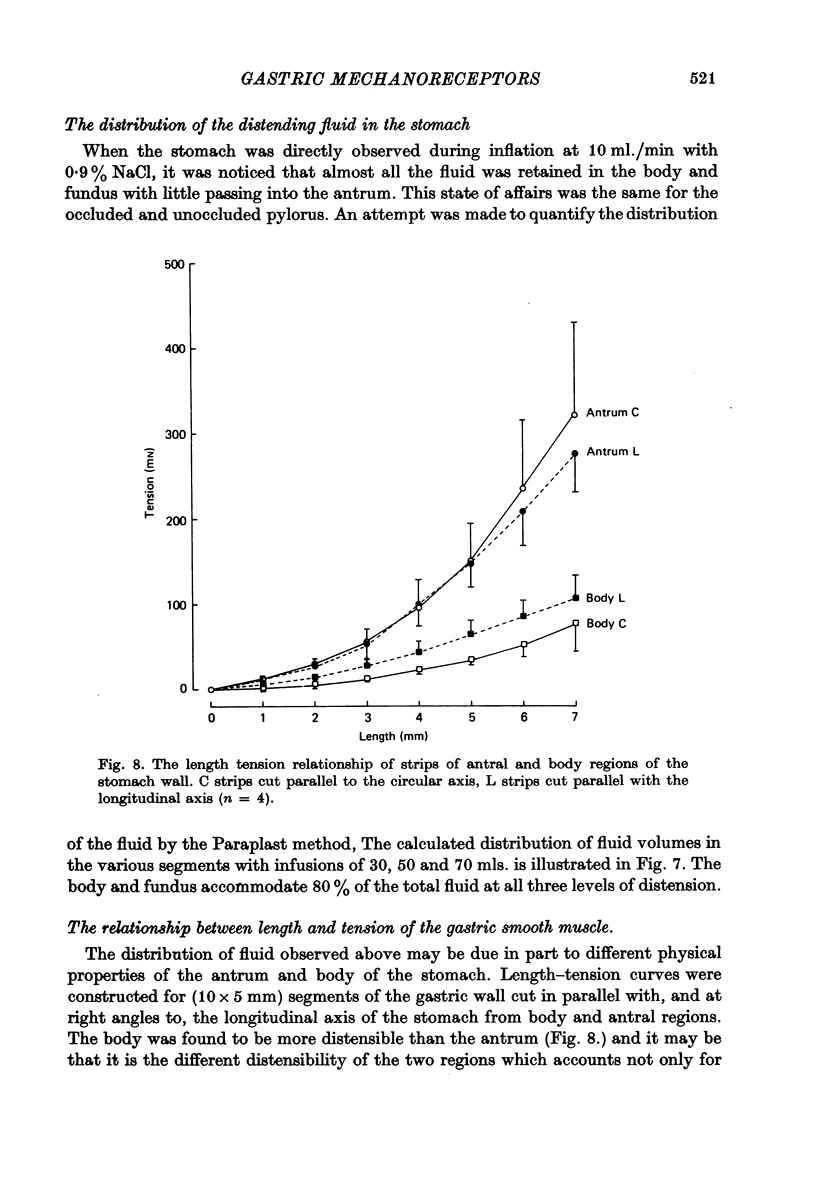Abstract
1. The rate and volume of gastric filling was estimated in conscious ferrets by measuring the amount of milk they would drink after an overnight fast. The mean volume was 94.5 +/- 7.5 ml. at a rate of 13.0 +/- 0.74 ml./min. An intragastric infusion rate of 10 ml./min to a total of 50 ml. was selected as a standard distension stimulus. 2. Action potentials were recorded from single gastric afferent fibres in the cervical vagus. All but two of thirty-six afferent units were tonically active when the stomach was deflated. 3. Afferent fibres arising from receptors in the antrum showed modulation in phase with spontaneously occurring antral contractions. Afferent fibres from the corpus and fundus, however, discharged at irregular rates between 0.35 and 7.5 Hz with no correlation with the intragastric pressure rises associated with the antral contractions. 4. Inflation of the stomach with 50 ml. 0.9% NaCl at a rate of 10 ml./min stimulated antral motility and the rhythmic afferent discharge from the antrum was enhanced Receptors in the corpus and fundus increased their rate of discharge with increasing gastric volumes. Receptors in the region between the antrum and the corpus had the property of both types so that they responded to both distension and contractions. 5. On distension with 0.9% NaCl, fluid is distributed unevenly in the stomach. 80% was accommodated in the corpus and fundus, the remainder of the fluid entering the antrum. 6. The tension was measured in strips of stomach wall taken from corpus and antrum. For equal increments of stretch the development of tension was greater in the antral than in corpus strips. This physical property together with neurally mediated receptive relaxation of the corpus is the reason for the fluid distribution described above. 7. It is concluded that the properties of the tension receptor are determined by their site in the stomach. Those in the body and fundus signal the degree of distension and those in the antrum signal information concerning the amplitude, rate and duration of antral contractions.
Full text
PDF











Selected References
These references are in PubMed. This may not be the complete list of references from this article.
- Abrahamsson H. Studies on the inhibitory nervous control of gastric motility. Acta Physiol Scand Suppl. 1973;390:1–38. [PubMed] [Google Scholar]
- Andrews P. L., Grundy D., Scratcherd T. Reflex excitation of antral motility induced by gastric distension in the ferret. J Physiol. 1980 Jan;298:79–84. doi: 10.1113/jphysiol.1980.sp013068. [DOI] [PMC free article] [PubMed] [Google Scholar]
- Blair E. L., Brown J. C., Harper A. A., Scratcherd T. A gastric phase of pancreatic secretion. J Physiol. 1966 Jun;184(4):812–824. doi: 10.1113/jphysiol.1966.sp007949. [DOI] [PMC free article] [PubMed] [Google Scholar]
- Cooke A. R. Control of gastric emptying and motility. Gastroenterology. 1975 Apr;68(4 Pt 1):804–816. [PubMed] [Google Scholar]
- Davison J. S., Grundy D. Modulation of single vagal efferent fibre discharge by gastrointestinal afferents in the rat. J Physiol. 1978 Nov;284:69–82. doi: 10.1113/jphysiol.1978.sp012528. [DOI] [PMC free article] [PubMed] [Google Scholar]
- GROSSMAN M. I. Secretion of acid and pepsin in response to distention of vagally innervated fundic gland area in dogs. Gastroenterology. 1962 Jun;42:718–721. [PubMed] [Google Scholar]
- HARPER A. A., KIDD C., SCRATCHERD T. Vago-vagal reflex effects on gastric and pancreatic secretion and gastrointestinal motility. J Physiol. 1959 Oct;148:417–436. doi: 10.1113/jphysiol.1959.sp006297. [DOI] [PMC free article] [PubMed] [Google Scholar]
- HUNT J. N., MACDONALD I. The influence of volume on gastric emptying. J Physiol. 1954 Dec 10;126(3):459–474. doi: 10.1113/jphysiol.1954.sp005222. [DOI] [PMC free article] [PubMed] [Google Scholar]
- IGGO A. Gastro-intestinal tension receptors with unmyelinated afferent fibres in the vagus of the cat. Q J Exp Physiol Cogn Med Sci. 1957 Jan;42(1):130–143. doi: 10.1113/expphysiol.1957.sp001228. [DOI] [PubMed] [Google Scholar]
- IGGO A. Tension receptors in the stomach and the urinary bladder. J Physiol. 1955 Jun 28;128(3):593–607. doi: 10.1113/jphysiol.1955.sp005327. [DOI] [PMC free article] [PubMed] [Google Scholar]
- Leek B. F. Abdominal and pelvic visceral receptors. Br Med Bull. 1977 May;33(2):163–168. doi: 10.1093/oxfordjournals.bmb.a071417. [DOI] [PubMed] [Google Scholar]
- Mei N. Mécanorécepteurs vagaux digestifs chez le chat. Exp Brain Res. 1970;11(5):502–514. [PubMed] [Google Scholar]
- PAINTAL A. S. A study of gastric stretch receptors; their role in the peripheral mechanism of satiation of hunger and thirst. J Physiol. 1954 Nov 29;126(2):255–270. doi: 10.1113/jphysiol.1954.sp005207. [DOI] [PMC free article] [PubMed] [Google Scholar]
- PAINTAL A. S. The conduction velocities of respiratory and cardiovascular afferent fibres in the vagus nerve. J Physiol. 1953 Aug;121(2):341–359. doi: 10.1113/jphysiol.1953.sp004950. [DOI] [PMC free article] [PubMed] [Google Scholar]
- Paintal A. S. Vagal sensory receptors and their reflex effects. Physiol Rev. 1973 Jan;53(1):159–227. doi: 10.1152/physrev.1973.53.1.159. [DOI] [PubMed] [Google Scholar]
- Strunz U. T., Grossman M. I. Effect of intragastric pressure on gastric emptying and secretion. Am J Physiol. 1978 Nov;235(5):E552–E555. doi: 10.1152/ajpendo.1978.235.5.E552. [DOI] [PubMed] [Google Scholar]
- Takeshima T. [Functional classification of the vagal afferent discharges in the dog's stomach]. Nihon Heikatsukin Gakkai Zasshi. 1971 Mar;7(1):19–27. doi: 10.1540/jsmr1965.7.19. [DOI] [PubMed] [Google Scholar]


